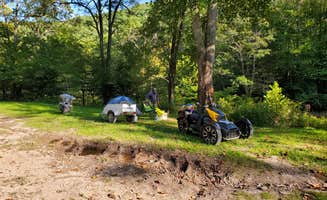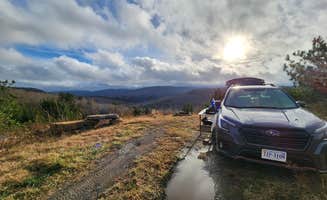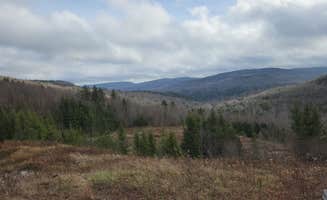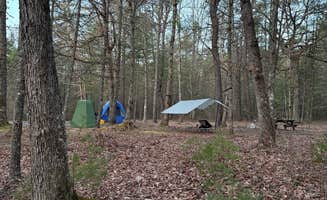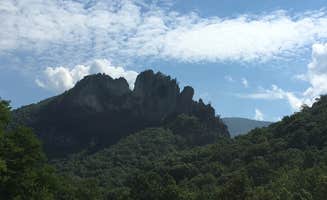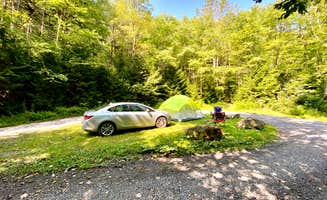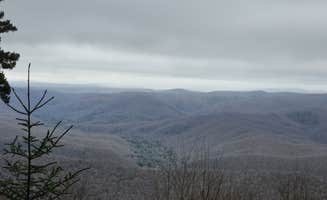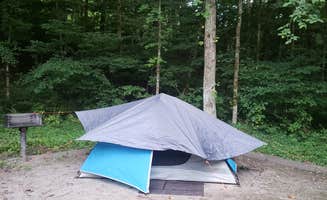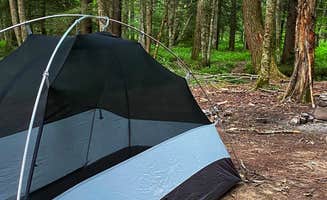Dispersed camping near Camden-on-Gauley, West Virginia takes place largely within the Monongahela National Forest at elevations ranging from 2,000 to over 4,000 feet. The forest contains over 115 species of trees, with northern hardwoods dominating lower elevations and spruce-fir forests at higher elevations. Summer temperatures typically range from 60°F to 80°F, while nights can drop into the 40s even during warm months.
What to do
Fishing opportunities: Several dispersed camping areas provide direct access to quality fishing spots. At Elk River Dispersed camping, one camper noted, "There is Elk Springs Resort & Fly Shop just down the road. Here you can hire a guide, or pay to fly fish their well stocked area." Many sites have catch-and-release restrictions, so check local regulations before fishing.
Hiking nearby trails: The Poor Farm Dispersed Recreation Area offers excellent trail access. A reviewer enthusiastically stated, "I'm all about trails so this place was greaaat!" The area connects to multiple forest service trails with varying difficulty levels, from short walks to challenging day hikes.
Wildlife watching: Many campers report wildlife sightings throughout the region. Early morning and dusk offer the best viewing opportunities. Keep food secured at all times and maintain a safe distance from animals. As one camper at Little River Dispersed Campsites warned, "Not even 2 minutes from our dispersed camp site we were charged by an extremely aggressive black bear."
What campers like
Privacy between sites: The spacious layout at Mower Basin creates a sense of seclusion. According to one camper, "The sites are so spread out/the foliage is so thick that you can't see or hear anyone." This allows for a more private camping experience even when other sites are occupied.
Riverside camping spots: Campers frequently praise the waterfront sites available at Little River Dispersed Campsites. One visitor described, "Beautiful spots by the river. Wildflowers and ferns and grassy spots right by the river. Some spots even have picnic tables and fire pits." These water-adjacent sites provide both scenic views and convenient water access.
Natural surroundings: The unique forest environments receive high marks from visitors. A camper at Gaudineer Knob camp sites described an almost otherworldly setting: "The forest floor is only moss. Like miles of moss and other than the trail that was it. No other trees either. Just Spruce. That combination created the world's most quiet environment ever."
What you should know
Road conditions vary significantly: Access to many sites requires traveling on rough forest roads. At Little River Dispersed Campsites, a camper cautioned, "We drove in from the south, through Durbin, which is almost 7 miles on a pothole ridden dirt road. Dangerous for RVs, great for those looking for an escape." Always check recent road conditions before setting out.
Cell service limitations: Don't count on having connectivity. At Mower Basin, one visitor reported, "I had no signal for almost two hours heading towards VA." Another noted, "I had T-mobile and got zero service. I wouldn't expect any carrier to get any service out there though."
Weather preparedness: The mountainous terrain creates localized weather patterns that can change rapidly. Pack additional layers regardless of season, as temperatures can drop significantly at night. At Army Camp, a camper witnessed how "the New River had encroached another 100ft through the woodland" after rainfall.
Tips for camping with families
Choose established sites: For camping with children, sites with some basic amenities make the experience more manageable. Army Camp offers "picnic tables, fire rings, and lantern poles. No drinking water, so bring your own. No hookups." These simple features can make family camping more comfortable.
Consider accessibility: Some areas have more family-friendly access than others. A visitor to Army Camp noted, "The road to access is a little sketch but worth the trip in." Always research the access road difficulty before bringing children to more remote sites.
Look for swimming opportunities: During warm months, riverside camping areas often have natural swimming spots. At Little River Dispersed Campsites, a camper shared, "When you park and walk down to the river, if you turn right, there's a beach area about 50 yards down that offers a great spot to take a dip!"
Tips from RVers
Site size awareness: Many dispersed sites have limited space for larger vehicles. However, some areas can accommodate smaller RVs. At Mower Basin, a camper reported, "We strolled up the mountain in our 39ft skoolie. It snowed and we had a really good time!" Research specific site dimensions before arriving with an RV.
Road clearance requirements: High-clearance vehicles are recommended for most dispersed camping areas. A visitor at Poor Farm noted, "Wasn't too hard to get there and park in our van," suggesting some sites are more accessible than others. When possible, scout locations with a smaller vehicle before bringing in an RV.
Plan for self-sufficiency: RVers should arrive fully prepared with all necessary supplies. As one Army Camp visitor advised, "Just remember you have to make that trip all the way back out if you forget anything at the store (like we did) so be prepared to have plenty of food and wood."


